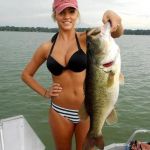Advertisement
Not a member of Pastebin yet?
Sign Up,
it unlocks many cool features!
- Trout fishing on spinning gear, by EastBayCAguy
- Equipment:
- Trout are notorious among sport fishes for being line shy, so I would recommend using 4lb copolymer or fluorocarbon line on your trout setup. The added advantage to this is that, from my experience, 4lb monofilament will cast better than 10lb braid on a spinning rod. Since you will want to use some pretty small lures sometimes, this is important.
- An ultralight rod is going to be plenty for most bank fishing for trout. Since you are using light line, the extra strength of a heavier rod will be wasted as you will need to set the drag light to accommodate the light line anyway. Exceptions include if you are throwing a lot of ¼ oz lures, or throwing crankbaits that have a lot of resistance in the water, you might want to move up to light action to feel more comfortable.
- Your choice of reel is not going to matter a lot, just pick something that has the right weight, good price and you think it will be reliable.
- Lures:
- There are obviously a lot of things out there that you could be throwing at some trout, and what works well varies by area and time of year so I’m just going to speak broadly and also talk about some things that have produced for me. Inline spinners are absolutely essential to have. They are like the bread and butter of trout fishing. Like having a senko shape worm as a bass fisherman. Get some silver and gold ones, some bright color ones, and some dark or natural color ones. You want to run these with a swivel to avoid line twist. The way I set this up is to get a really tiny swivel and tiny split ring. Tie the swivel to the line, attach the split ring to the other end of the swivel. Switch out spinners by removing them from the ring and putting another one on. Faster than retying. Usually you fish an inline with a moderate steady retrieve to keep the blade moving.
- Another thing that works well is a grub or tiny paddle tail plastic. I find these to work best when the fish seem picky about what they will bite. Colors I have caught on personally are root beer and carolina pumpkin, natural colors on the brown end of the spectrum. That said, try other colors, like pink, chartreuse, black, or white. As a fisherman you should have a lot of grubs anyway since they are a good basic lure for many species. Grubs at 1 or 2 inches are what I’ve caught on. A fairly slow retrieve seems to work best for these, so keep that in mind when you decide how heavy a jig head to use.
- Trout will also hit crankbaits. Generally small ones in the 1 to 3 inch range will give you the best chances. Lures with slender minnow profiles are the best ones. Find a couple that look good and give em a shot. It’s a good way to target larger trout.
- Spoons are similar in use to inline spinners, good for covering a lot of water. The compact shape and weight of some, especially kastmaster spoons, allows you to reach deep water, such as shore fishing in a lake.
- Finding Fish:
- In flowing water, there are a few areas to look for to find trout. They have an ideal speed of water movement that blows food by them but doesn’t tire them out. On big, slow rivers like the American river in CA, trout will be in areas on the tail end of a rapid where the fast water slows down and reaches their ideal pace. The head end of a rapid is also sometimes productive. In a fast flowing stream, like you might find in the mountains, trout will be in pools where the water slows down. In areas that look good for trout, you can narrow your search further by finding rocks or logs which interrupt the flow of water or undercut banks that provide shade. Traditionally, anglers try to move upstream, cast upstream ahead of themselves, and retrieve the lure in the direction of current to appear like natural prey. On large rivers, this doesn’t matter as much since the fish are likely far away and won’t be spooked. In very fast water, retrieving with the current coming from behind the lure can kill the action, so don’t feel that you have to cast upstream.
- In lakes, trout will usually be behaving in one of two ways. They will be in open water, either near the surface or further down, or they will cruise along in the shallow parts of the lake, hunting for food. This is going to depend on the time of year and the temperature. Find out what the fish are doing in your area. Areas that drop off steeply into deep water are good if you want to catch deeper holding fish from shore. Otherwise just fan casting from a good looking spot is probably going to work for you.
Advertisement
Add Comment
Please, Sign In to add comment
Advertisement

